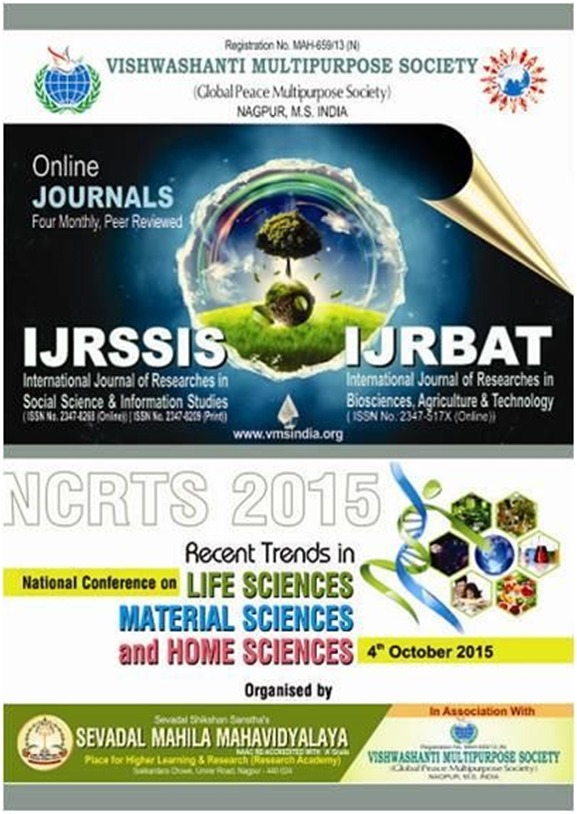The specific objective of this National Conference on “Recent Trends in Life Sciences, Material Sciences and Home Sciences” is to provide multidisciplinary platform to consolidate insights and to explore interface of current trends in Life Science, Material Science and Home Science innovations and to indicate how different branches of the Life Sciences and Material Sciences relate to one another. The development of the Life Science and Material Science and its expansion into other disciplines like Home Science transformed science landscape with an improved quality of life for all. The history of Life sciences has changed from the classification of living organisms and Darwin's theory, to the world of cell Biology, and now to the world of molecular biology with revolutionary ideas in Recombinant DNA Technology. Material Science is a multidisciplinary field that relates the behavior and properties of various materials with aspects of their molecular structures and their chemical and physical characteristics at the atomic or molecular level. This area encompasses several disciplines like Chemistry, Physics, Engineering and Technology. Home Science provides Knowledge on the latest developments in Food and Nutrition Science, Textile and Clothing, Human Development, Family Resource Management Studies and Community Extension Education Programmes.
We have received an overwhelming response for this conference from participants. There are total 270 registered delegate and 96 research students from various universities of Maharashtra and few are from other states like Madhya Pradesh, Chhatisgarh, Goa and Uttarakhand. We have received eminent resource persons From IIT Kanpur; VNIT Nagpur; Department of Botany, Dr. Babasaheb Ambedkar Marathwada University, Aurangabad; SNDT Mumbai and Nagpur Veterinary College, Nagpur for plenary lectures. This conference has been designed with invited lectures, oral presentations and poster presentations. Conference accepted papers have been published in the online International Journal of Researches in Biosciences, Agriculture and Technology. In this conference we have received 149 full length papers for publication out of which 54 are from Life Science, 43 are from Material Science and 52 are from Home Science. Similarly, we have received total 56 abstracts for paper presentations in six technical sessions; two each for Life Science, Material Science and Home Science.
I would like to extend my deepest thanks to the Dignitaries, Distinguished Speakers, Guests, Delegates and Students, who have come from different parts of the country, to grace the occasion. This Conference report summarizes the proceedings and outcomes of the National Conference.
Dr. Anil Mohite Convener
Dr. A. S. Mohite
Convener
Editorial Board
Dr. S. V. Kulkarni - Co-Convener
Dr. Ashish Lambat - Co-Convener
Dr. R. D. Gadewar - Joint Organizing Secretary
Publication Committee
Mr. Ajay Dorlikar
Dr. Mrs. K.V.Dubey
Dr. Mrs. Nirupama Dhoble
Dr. Mrs. Hemlata Padole
Registration Committee
Dr.(Mrs.) Anjali Mahakalkar - Co-Convener
Dr. Prabhakar Bhandari - Organizing Secretary
Dr. Vinod Dongre - Joint-organizing Secretary
Dr.(Mrs.) A. R. Rathkanthiwar - Member
Dr.(Mrs.) J. B. Tirpude - Member
Dr.(Mrs.) J. S. Dahegaonkar - Member
Dr.(Mrs.) M. P. Patil - Member
Mrs. A. M. Durugkar - Member
Hospitality Committee
Mr. P. S. Deshpande - Co-Convener
Dr.(Mrs.) N. S. Dhoble - Organizing Secretary
Dr.(Mrs.) N. A. Tiwade - Joint-organizing Secretary
Dr.(Mrs.) M.Joharapurkar - Joint-organizing Secretary
Mr. R. R. Nagpur - Member
Dr.(Mrs.) Sadhna Bhoyar - Member
Dr.(Mrs.) A. S. Dhoble - Member
<>Dr.(Mrs.) P. P. Chahande - MemberMrs. J. D. Kamble - Member
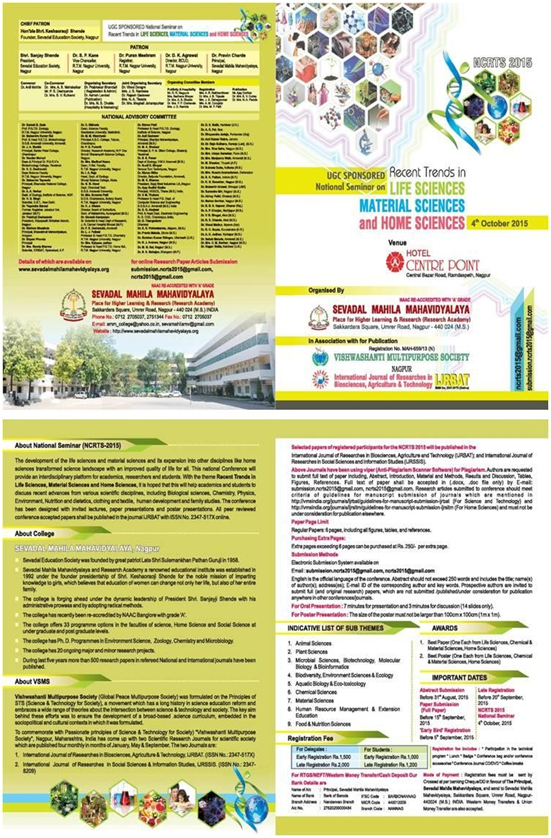
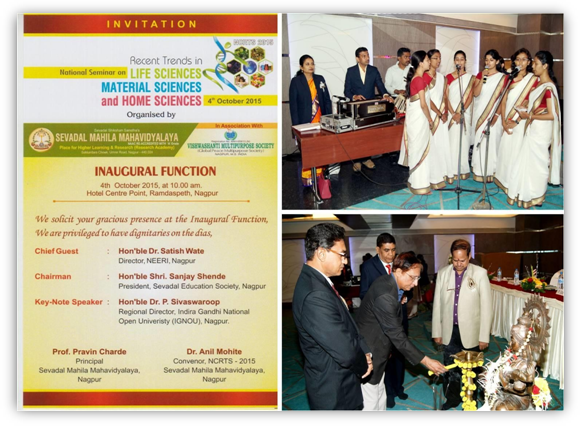
At the onset, in his welcome speech Prof. Pravin Charde, Principal, Sevadal Mahila Mahavidyalaya, Nagpur welcomed all the guests, participants, teaching fraternity and research scholars from every part of the country. He appealed the august gathering to inculcate scientific temperament for the sustainable development and wellbeing of the society. He proposed that we should develop the research attitude and ability towards speculative perspective through which we look at multidimensional aspects of Science and Technology.
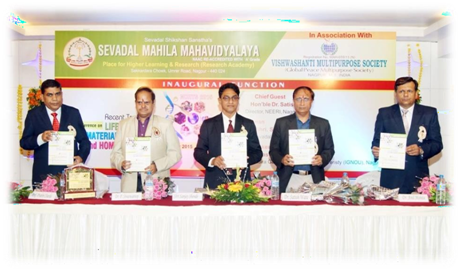
Dr. Satish Wate, Director, NEERI, Nagpur in his Chief Guest Speech, congratulated the Department of Music for presenting University song and Saraswati stavan which in real sense served the purpose of preserving the national harmony. He further said that the conference has sought a perfect blend of interfacing the three interdisciplinary sciences through which the concerning issues of health and nutrition should be brought in. He appealed the gathering that our goal should not be the collection of information but we must know how to use that information to convert knowledge into technology and finally into a product. This principle should be the ultimate goal of research and development.
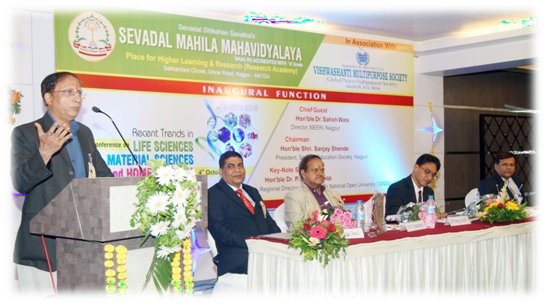
Shri Sanjay Shende, President, Sevadal Education Society, Nagpur, in his Presidential address said that the College has always been on the forefront by organizing such conferences to discuss the role of Life Science, Material Science and Home Science through which the contemporary burning issues in these interdisciplinary branches of thoughts are brought to a limelight. He also congratulated the Principal and staff members of the College who took whole-hearted efforts in the development of an institution.

Dr. Anil Mohite, Convener of the Conference focused upon the thrust areas of the conference and congratulated the delegates and research scholars for showing vehement response for the conference. He said that the teaching fraternity, guests and research scholars showed their overwhelming response in the multi-disciplinary fields encompassing various disciplines ranging from Chemistry to Home Science. Near about 450 plus delegates have participated in the conference and they will add something to the field of research and development by presenting their research papers, posters and oral presentations.
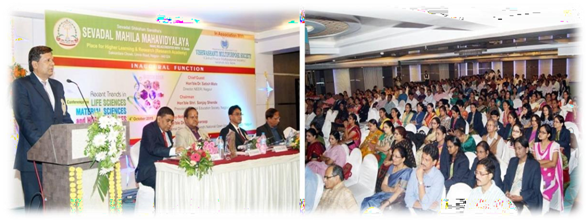
Dr. P Sivaswaroop, FRSC (London), Regional Director, IGNOU Regional Centre, NAGPUR began his Keynote address on “Omni Potent Nano Materials” by saying“Small is Beautiful” and today’s technological advances are also taking us in that direction. From a room sized micro computers to present day Palm Top Smart Phones (inbuilt with multiple functions), Huge X – Ray Machines to small hand held scanners etc. Nano Technology is playing key role in this transformation.
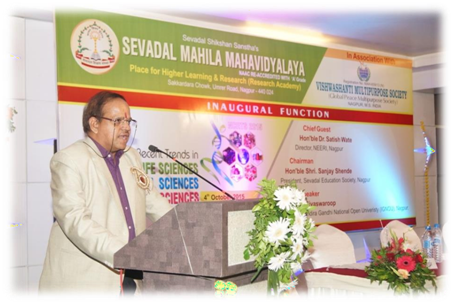
He pointed out that, in 1974, Norio Taniguchi defined the term Nano Technology and Synthesis of Fullerenes in 1990 and Carbon Nano Tubes (CNT) in 1992 has triggered Research in Nano Materials. Today it is difficult to assess, how many products in the Market contain Nano Particles or, are manufactured with the help of Nano Technologies. And, the Nano Research is still the hot research topic across the globe in almost all fields like defense, Material Sciences, Food Sciences, Cosmetics, Building materials etc. Nano Materials exhibit extra ordinary properties, like Copper becomes Super Hard material at Nano Scale. Nano Technology creates and uses structures that have novel properties because of their Nano scale size. Nano Materials are designed with requisite properties. He has discussed in detail the applications of Nano Materials in all fields of Human life and some of them are as follows: In Medical Sciences, like Tissue Engineering, Target specific Drug Delivery, Hip Replacement Surgery, and dental Surgery etc. In Building Materials, to develop light weight material, UV protecting glass coatings etc. to detect and remove environmental contaminants in Air, water and Soil, and Electronic Nose for detection of pollutants, in cosmetics, in house paints, in High definition (HD) TVs, in Food Industry, for protective packaging of material and even developing new food products etc.
Parallel Session of Life Science
First Technical Session was started at 12.10 pm. In hall number one. The guest speaker was Dr. Manoj S. Patil, Department of Animal reproduction, Veterinary College,Nagpur. Chairperson was Dr. R. J. Andrew, Head Department of Zoology, Hislop College, Nagpur. Co-Chair Person was Dr. Mrs. A. S. Kulkarni, Head, Department of Mcrobiology, Dharampeth Science College, Nagpur. Raporteur was Dr. (Mrs.) S.V. Kulkarni. All of them were felicitated by offering floral bouquet and memento. The jury Members were I) Dr. M. M. Rai II) Dr. (Mrs.) A. S. Shanware and III) Dr. Vijay Wadhai were felicitated by offering bouquet.
Dr. Manoj S. Patil, Department of Animal Reproduction, Gynaecology and Obstetrics, Nagpur Veterinary College, Nagpur Spoke on use of assisted reproductive techniques for conservation of endangered species is a big challenge because of the broad biological variability between the species and the paucity of knowledge about the basic reproductive biology. Basic research is helpful in developing and applying assisted reproductive techniques (ART) such as artificial insemination (AI), in vitro fertilization (IVF) and embryo transfer (ET). However, the existing knowledge of domestic animals on similar aspects cannot be directly applied to wild animals or even closely related species within the same taxon, because of the marked physiological differences in reproductive behaviour. Therefore, each species needs to be studied with the aim to determine the similarities and differences between the species. By evaluating the basic reproductive traits, it has been possible to establish the normal databases for various endangered species. Basic requirements and constraints while implementing the assisted reproductive techniques in wildlife conservation (Rhinoceros, Felids, Avian, Cervids and Ungulates Species) are discussed in brief.
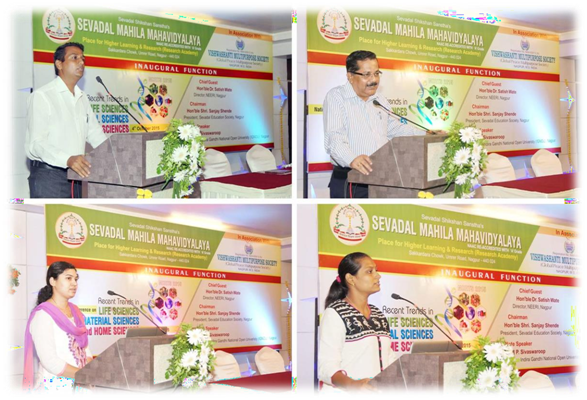
Following papers were presented in first technical session:
| Sr.No. | Name of participants | Topic |
|---|---|---|
| 1 | Minal Trivedi (Biotechnology) | Amelioration of liquid potassium bioinoculant: An approach towards promoting sustainable agriculture. |
| 2 | A. Darokar (Biotechnology) | The inventive approach for development of liquid formulation using fluorescent Pseudomonas isolates. |
| 3 | K. Talreja (Biochemistry) | Glucosinolates and myrosinase from brassica oleracea: As an anticancer therapeutic. |
| 4 | A. R. Deshpande (Microbiology) | Fungitoxic potential of Cinnamomum zeylanicum against soil borne fungal pathogens of Vigna radiate (L.). |
| 5 | S.A.Mankar (Biotechnology) | Study of haematological parameters of blood of Clarias batrachus (walking fish). |
| 6 | Pallavi Sahare (Biochemistry) | Penicilium binding proteins: Antibacterial target with new avenues. |
| 7 | Sushama Meshram(Microbiology) | Screening of pathogenic flora from raw milk and milk products. |
Parallel Session of Material Science
Technical Session was started at 12.10 pm. The guest speaker was Prof. N. S. Gajbhiye, Department of Chemistry, IIT, Kanpur. Chair Person was Dr. K. B. Ghormare, Head Department of Physics, VMV College Nagpur and Co-Chair Person was Dr. Mrs. G. K. Patki, Sindhu Mahavidyalaya, Nagpur. Raporteur was Dr. (Mrs.) M. P. Patil. Jury Members were I) Dr. L. P. Damodhare II) Dr. N. K. Kulkarni. Guest speaker Prof. N. S. Gajbhiye, Department of Chemistry, IIT, Kanpur has delivered his talk on “Nanomaterial’s,it’s Preparation & Applications.” In his speech he spoke on kinetic and thermodynamic mechanism of these materials. He said it’s era of Nano science & more stress should be given on this topic by upcoming researcher. Two participants have participated in oral presentations.

Home Science
Invited Talk: Dr. (Mrs.) Armaiti Shukla, HOD of Textile, SNDT, Mumnai.
Chair Person: Dr. (Mrs.) Smita Kawale, Yeshwant Mahavidyalaya, Wardha.
Co-chair Person: Dr. (Mrs.) Kalpana Patankar, MP Deo Memorial Dharampeth Science College, Nagpur.
Raporteur: Dr. (Mrs.) Sadhna Bhoyar, Sevadal Mahila Mahavidyalaya, Nagpur.
Dr. (Mrs.) Armaiti Shukla, HOD of Textile, SNDT, Mumbai focuses on the use of aqueous extract of Curcuma L. (Turmeric) as an antibacterial agent on nonwoven cotton textiles. The samples were tested against Gram Positive bacteria S. Aureus and Gram Negative bacteria E.coli. The samples displayed good anti bacterial activity. Turmeric contains about 5% of volatile oil, resin and curcuminoids. The chief component of curcuminoids is known as “curcumin” and is reported to be responsible for the characteristic yellow colour of the dye. This yellow color was first isolated by Vogel in 1842 and in 1910 Lampe and Milobedeska identified the structure of curcumin as (C12H20 O6). Cellulosic clothing in Indian climatic conditions is prone to microbial attack because of high presence of humidity. Recent research has focused on the ancient art of natural dyeing to provide anti microbial properties which could be used for the production of medical textiles such as wound dressing, sutures, surgical gowns, etc. The consumer on

the other hand is searching for fabric and garment options that are both eco friendly and have enhanced properties as wellness products. The plant based natural extract of Turmeric which contains Curcumin has been studied for its effectiveness on several microbial strains and shows promising results on A. flavus, A. parasiticus, E.coli, S. aureus, P. aeruginosa, etc.
Life Science
Dr. A. A. Dhamani, Principal, Gramgeeta College, Chimur was Chair Person and Dr. D. M. Mate, Nutan Adarsh College, Umred was Co-Chair Person. Rapporteur was Mr. A. V. Dorlikar, Sewadal Mahila Mahavidyalaya, Nagpur for the IInd Technical session of Life sciences. Dr. Milind Sardesai, Department of Botany, Dr. Babasaheb Ambedkar Marathwada University, Aurangabad has delivered plenary lecture entitled, “The Diversity of non-vegetarian plants in India”.

Dr. Milind Sardesai, in his invited talk pointed out that, few plants have evolved the capacity of feeding directly on animals for their supplementary nutrition. Characteristic ability to capture prey is to gain supplementary nourishment from it. Autotrophic nourishment of plants is for carbohydrate nutrition. Chief mode of nutrition is photosynthetic and Carnivorous habit is only an adaptation to make up nitrogen deficiency. Carnivorous plants are seen in habitat like Swamps and Bogs and soil have low level of consumable nitrogen. Plants have usually slow and slight movement ability to absorb nourishment through leaves. Plants imprison insects to achieve pollination. All these factors together make the plants carnivorous? Potato, tomato, tobacco, Plumbago and many others plants trap insects, which die from starvation. These plants have one or more features common to carnivorous plants. This is known as proto-carnivory. Carnivorous plants show two types of traps for capturing the insects. Active Traps - Plant shows movement to trap and kill the prey. Eg. Aldrovanda, Dioneaea, Utricularia, Drosera and Passive Traps- Plant do not show any movement to trap the prey. Eg. Nepenthes, Sarracenia.
Dr. M. M. Rai, Dr. (Mrs.) A S Shanware and Dr. Vijay Wadhai were the juries for evaluation of oral presentations. Following were the oral presentations.
| IInd Technical Session (Life Science) | |||
|---|---|---|---|
| 1 | Mr.R. U.Gadpayle | Fungal secondary metabolites: the genetics, biotechnology and industrial perspectives | Microbiology |
| 2 | Mr. N. A.Manwar | Diversity and abundance of Dragonflies and Damselflies (Order - Odonata) of Bhivapur Range in Pohara – Malkhed Reserve Forest, Maharashtra (India) | Zoology |
| 3 | Mr. S. N.Khade | Underwater Survey of Bivalve and Gastropoda Molluscs from Raigad district, Maharashtra, Coast of India | Zoology |
| 4 | Mrs. S.S.Khandare | Inhibitory activity of Lactic acid bacteria against pathogenic and spoilage organisms associated with Chicken | Microbiology |
Material Science
Dr. K.P. Kariya, Associate Professor, Department of Chemistry, V.M.V. College, Nagpur was Chair Person and Dr. P.K. Rahangdale, Chairman of BOS in Chemistry, RTM Nagpur University & Head, Department of Chemistry, Bhawabhuti Mahavidyalaya, Amgaon was Co-Chair Person. Rapporteur was Dr. (Mrs.) P.P. Chahande, Sewadal Mahila Mahavidyalaya, Nagpur for the IInd Technical session of Material Sciences. Dr. D.R. Peshwe, Professor and Head, Department of Mettalurgical and Material Engineering, VNIT, Nagpur has delivered plenary lecture entitled, “Miracles of Nanomaterials and its impact on the society”.
Dr. D.R. Peshwe began his lecture with the issue of use of materials through ages. He emphasized the influence of changing materials on the human society and ecology in general. In his interesting presentation he amazed the gathering by enlightening the audience about the fact that nanotechnology has its roots in Vedas and Purans. It was an enchanting lecture also spoke on various uses of nanomaterials. He explained the amazing use of nanomaterials in drugs delivery directly to the affected region of the body avoiding the side effects to other vital organs.
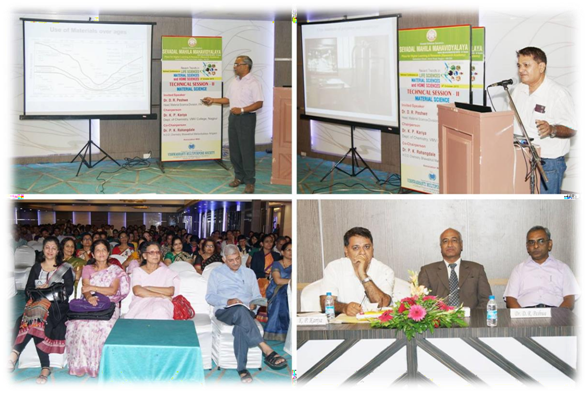
Home Science
Invited Talk: Dr. (Mrs.) Anuradha Mitra, HOD of Food and Nutrition, Nirmal Niketan College of Home Scoence, Mumbai.
Chair Person: Dr. (Mrs.) Kalpana Jadhao, PGTD of Home Science, RTM Nagpur University, Nagpur.
Co-chair Person: Dr. (Mrs.) Rekha Sharma, UGC-HRD Centre, RTMNU, Nagpur.
Raporteur: Dr. (Mrs.) Meghali Johrapurkar, Sevadal Mahila Mahavidyalaya, Nagpur.
Dr. (Mrs.) Anuradha Mitra in her plenary lecture presented views on “Eat to Live or Live to Eat, The Indian Paradox”. She spoke on Food Preservation, Malnutrition problem specifically, the vulnerable section i.e. Children and Pregnant women, Food availability and related problems, Low income and purchasing capacity of masses, Problems of Storage and distribution, customs superstitions and taboos and life style diseases.
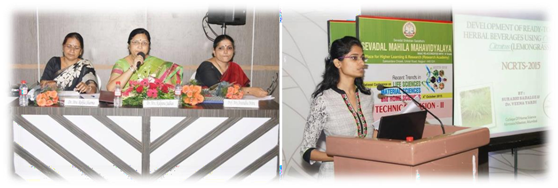
Jury for Poster presentation
1. Dr. I A Raja
Co-Chair Person1. Dr Mrs. Chitra Deshmukh
Life Science1. Dr. K G Patil
2. Dr. K N Sathawane
3. Dr. A D Bobdey
1. Dr. K G Rewatkar
2. Dr. Mrs R D Batra
Home Science1. Dr. Mrs Vandana Dhawad
2. Dr. Mrs Veena Yardi

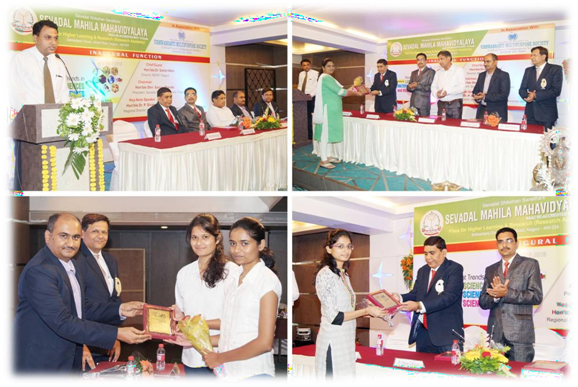
Chief Guest,Dr. M A Shahezad, Principal, S P M Gilani Mahavidyalaya, Ghatanji, Yavatmal; Guest of Honor, Dr. Pravin Telkhade, President, Vishwashanti Multipurpose Society; Guest of Honor, Dr. Shital Watile, Secretary, Jagdambha Group of Institutions and Jagdambha college of Engineering & Technology, Yavatmal.
Poster presentation Awardees
Life Science
A. B. Butle and M. B. Patil: Isolation of immunomodulatory protein from the seeds of Zizyphus mauritiana.
Material Science
M. M. Kolte, V.B.Pawade1 andS.J.Dhoble: Synthesis and Characterization of Eu2+activated KNa3Al4Si4O16phosphor
Home Science
Bhavana S. Bhujade, Riya D. Doifode, Bharati Ganu: Durva: an Anti-fungal Agent.
Oral presentation Awardees
Life Science
Pallavi Sahare: Penicillin Binding Proteins: Antibacterial target with new avenues
Material Science
A. S. Kakde: Application of zinc nano ferrite in recording storage devices.
Home Science
Surabhi Sadalge: Development of ready-to-drink herbal beverages using Cymbopogoncitratus (lemongrass) and studying its shelf life.

